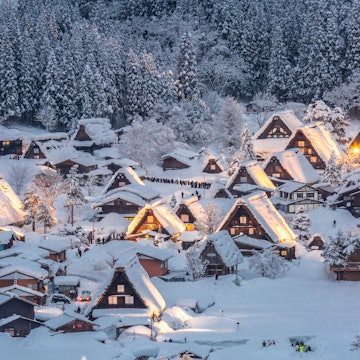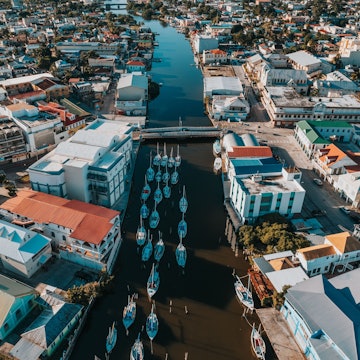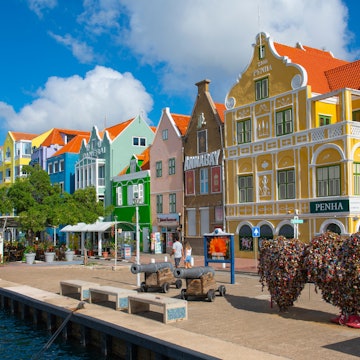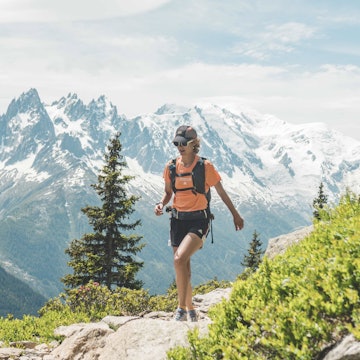
Why I traveled to the rainforests of Belize to learn about medicinal plants
Jan 10, 2022 • 10 min read

Alex Schechter is guided through Elijio Panti National Park with a practicing Mayan healer who’s well-versed in the native flora © Aquila Flores / Lonely Planet
A seldom-visited corner of Belize offers writer Alex Schechter a fresh perspective on his battle with cancer.
A month before I flew to Belize last fall, I called my oncologist. I was planning to visit a national park named after Don Elijio Panti, a famous Maya healer, where I hoped to learn about native medicinal plants. I wanted to know what my doctor, a non-Maya Belizean with a calm, jovial demeanor, thought of the “bush medicine” that remains so popular in his home country.
I began seeing Dr. Grant soon after my surgery for testicular cancer, five years ago. Despite the sobering nature of my visits, our conversations were always enjoyable. He knows I’m a travel writer, and he often hinted (not too subtly) that I should write about Belize. When I called and explained the specific subject of my search, he recalled how his grandmother would cure toothaches and upset tummies using roots and leaves from her backyard. He admitted that “sometimes, some of those things worked pretty well.” But the oncologist in him was more skeptical.
“People begin making broader claims,” he explained over the phone. “They say, ‘This one plant cures everything from diabetes to cancer to memory loss.’ Like all things, it becomes outlandish.” I learned that Dr. Grant had been treating cancer patients in Belize since 2008 at a cancer clinic he founded (the country’s first), something that had never come up in our earlier conversations.
Away from the beach, into the rainforest
Up to now, my impressions of Belize were mostly based on photos I’d seen of tropical white sand beaches and blissed-out snorkelers. This trip, however, would involve winding jungle trails, sacred Maya caves and medicinal tree bark. I found a hotel, the Gaïa River Lodge, that bordered the edge of Elijio Panti National Park, a sprawling wilderness in the west Belize district known as Cayo. The hotel offered guided “shaman” tours through the forest, which felt like a good starting point to better understand the role of traditional medicine in the country.
Dr. Grant seemed pleased that I had chosen to go to Cayo, a less-traveled area of Belize. So often, he said, tourists stick to all-inclusive resorts on the cayes, or islands and avoid the mountainous region further inland. “They miss out on all that green,” he said.
The 23 best things to do in Belize: snorkeling, fishing and cave tubing

Botanical treatments with a Maya healer
On a drizzly Saturday morning, I met with Jose Magaña, a practicing Maya healer who’s well-versed in the native flora of Elijio Panti National Park. He greeted me in the lobby of Gaïa River Lodge wearing baggy cargo pants and a woven linen shirt. Soon, we were traipsing through the rainforest, crushing allspice leaves in our hands and slicing slivers of Billy Webb bark to use as a mosquito repellant.
I learned that Magaña’s grandfather was a nephew of Elijio Panti, the park’s namesake. Like his famous relative, Magaña takes his role as a healer very seriously. His patients come from all over the Cayo district, seeking treatment for diabetes, migraines, asthma and a host of other afflictions. But as he explained, the business of curing them involves more than just picking the right leaf: “What’s missing are the prayers,” he said, snapping off a purplish stem of bullhorn acacia. “You cannot harvest the herbs just because you want to. You have to talk to the plants.”

Soon, Magaña began hopping up and down on a red dirt mound, causing a small army of leafcutter ants to emerge from tiny holes near the top. Magaña seized one and allowed its mighty jaws to clamp down on his pinky nail. When he pulled, the ant did not let go. This, he explained, was the Maya precursor to surgical stitches: instead of thread, a series of leafcutter ants would attach directly to the torn skin, and their powerful bites would help seal the wound. I winced at the thought of putting their scissor-shaped heads on the site of my own stitched incision, just above my pubic bone.
Into the place of fright
We crossed a shallow stream known as Vaqueros Creek, climbed up a field where thigmotropic weeds folded at my touch as if by magic, then swerved back into dense jungle. At the end of a corridor of massive, arched cohune palms, we reached the entrance to an underground cave. Magaña said this was Xibalba, a sacred Maya cave meaning “place of fright.” But scared was the last thing I felt as Magaña gently lowered himself to the ground and uttered a welcome prayer before entering. When he finished, we strapped on helmets with flashlight beams and climbed down a ladder into the murky hollow.

Magaña refers to himself as a h’men, Yucatec Maya for “one who knows” (he carefully avoids the word shaman, which is typically associated with sorcery and dark spirits). We ducked under jagged, pale yellow stalactites, passed through a series of labyrinthine tunnels and finally arrived at the cave’s innermost chamber, where we sat down for a traditional Maya ceremony. Magaña lit four white candles in the dirt, filled a wooden bowl with a piney resin used for incense called copal and unraveled a cloth containing several crystals and an obsidian blade.
“Some people get confused,” he said. “They see a stone and they think ‘magic.’ No! These are symbols,” he said, pointing to the items surrounding him. There were no chants or invoking of spirits. Instead, he spoke, reflecting on the importance of setting a good example for younger generations. He sprinkled a fistful of dried rosemary into the burning copal, and we sat there in silence. As the smoke swirled up towards the cratered, calcified roof, the auditorium-sized chamber took on a ghostly quality, as if the collected prayers from past generations of jungle dwellers were all humming in the air at once. It felt like the safest place I could imagine.

When we emerged in the daylight, the forest was serene and dappled in light. I asked Magaña why he was comfortable sharing such an intimate ritual with someone like me, a tourist. “I want to show people that we, the Maya, are still here.” He pointed at his t-shirt and backpack. “We dress in modern clothes, but that doesn’t mean we’re not Maya.”
Elijio Panti National Park recovered
Elijio Panti National Park was established in 2001, and today, it stands as a cultural symbol for the thousands of indigenous people who call this corner of Belize home. But its protected status has been shaky. In 2009, the Itzama Society, the local, all-Maya council who co-manages the park with the Belize Forest Department, lost its joint stake, and for 10 years, the 13,006-acre park languished at the hands of poachers, looters and loggers. “It was sad,” recalled Maria Garcia, the society’s chairwoman, and a niece of Don Elijio Panti. “This forest is our life. We have grown with it. It’s part of us.”
The Itzama Society regained co-management of the park in 2019 after a two-year negotiation with the government, and Garcia set her focus on community outreach. She began inviting Maya students as young as 13 to come for weekend workshops led by Maya elders. “The young people are hungry for it,” Garcia told me. “For some, it was their first time being in a Maya ceremony.”

Seeing the park through a ranger's eyes
Two days after my hike with Jose Magaña, I traveled to the park’s remote interior and received a private tour from Abdon Tzib, who grew up in neighboring San Antonio. Tzib is one of four rangers who work on a volunteer basis, clearing trails and patrolling an area the size of Manhattan. Walking under a pristine canopy of sapodilla trees, he pronounced the park’s full name – Noj Kax Meen Elijio Panti National Park – and explained that it was a reference to a Yucatec Maya term meaning “the grandmother forest of healers.”
Tzib does not consider himself a h’men, but during our walk, he pointed out the medicinal properties of fragrant lemongrass, avocado leaf, wild pineapple leaves and something called firebush, which can supposedly help with women’s menstrual cramps. “That’s a really good plant to have around,” he commented. He named so many plants, I lost count. I trailed behind as he plunged confidently into thickets of vines and leaves, zeroing in on the exact specimen he was after. His affection for the plants was obvious. At one point, he seized the spiky pods of an achiote tree and opened them to reveal crimson annatto seeds, which he smeared on the palm of my hand.
A personal approach to healing
I never mentioned my cancer to either of my botanical guides, mainly because it plays such a small role in my life today. Five years after my recovery, I am more interested in learning about other cultures’ attitudes to sickness, and the conditions that lead to it, than the particulars of my past diagnosis.

Walking with Magaña and Tzib, both of whom in their own way continue the h’men tradition that Elijio Panti popularized, I was struck by the Mayas’ personal, big-picture approach to healing. I wondered what it would be like for oncologists, as we know them in the US, to consider a patient’s underlying emotional state when prescribing treatment.
Magaña told me his patients often complained that they were victims of an enemy’s curse. He was quick to challenge such reasoning: “Not everything that happens to you is black magic,” he warned them. “Sometimes, we create our own problems. If we don’t accept that we’re suffering, how are we going to get better?”

From the medicine of a jungle to a cancer clinic
On my last day in Belize, I drove three hours to the coast in Dangriga, to visit the cancer center that Dr. Grant founded. I was curious to see his other office and also to find out how my lessons in the jungle measured up against the harsh realities of more invasive treatments like chemotherapy. (Testicular cancer like mine has a 95% survival rate, and rarely requires radiation or chemotherapy.)
I rang the buzzer to a modest two-story building, which turned out to be Dr. Grant’s childhood home. A nurse led me through a small waiting room stocked with American magazines and framed pictures of tropical beach scenes. Only one patient was present: a 5-year-old boy receiving an intramuscular injection for leukemia. Behind him, his smiling father and younger brother sat quietly, the smaller boy distracted by a video game.

Unlike the highlands of Cayo, coastal Belize was muggy and hot. I stood sweating in the waiting room, quizzing the nurse about home remedies like noni juice and soursop tea, which many Belizeans (not just Mayas) consider to be natural antidotes to cancer. He shrugged. “If it works, it works. But with targeted therapy, we can say ‘x’ amount of chemo will have ‘x’ result. We can back that up scientifically.”
Another problem was early detection. Most patients, the nurse explained, didn’t bother coming into the clinic until they were in bad shape. And once the cancer had metastasized, it was unlikely that any form of treatment – chemical or otherwise – would be of help.
My journey with cancer
I thought back to the summer of 2016, that frightful, whirlwind week when I discovered the lump in my scrotum, scheduled an appointment with a urologist and was booked for surgery the following day. I found my cancer early before it could do any real damage. I was also lucky enough to have access to decent healthcare and a family that rallied around me.
After the surgery, I had a feeling of being reborn and a newfound respect for the subtle workings of my own body. This awareness, the desire to understand exactly what I am feeling in all moments, has stayed with me. As any healer would tell you, that is just as important as the medicine itself.
You might also like:
8 reasons Belize should be on your radar
Exploring the flavors and melodies of Belize
Belize: your guide to adventure activities
Belize is on our 2022 Best in Travel list. For more stories from some of the world’s most exciting destinations click here.
Safety recommendations and restrictions during a pandemic can change rapidly. Lonely Planet recommends that travelers always check with local authorities for up-to-date guidance before traveling during Covid-19.












